Making It
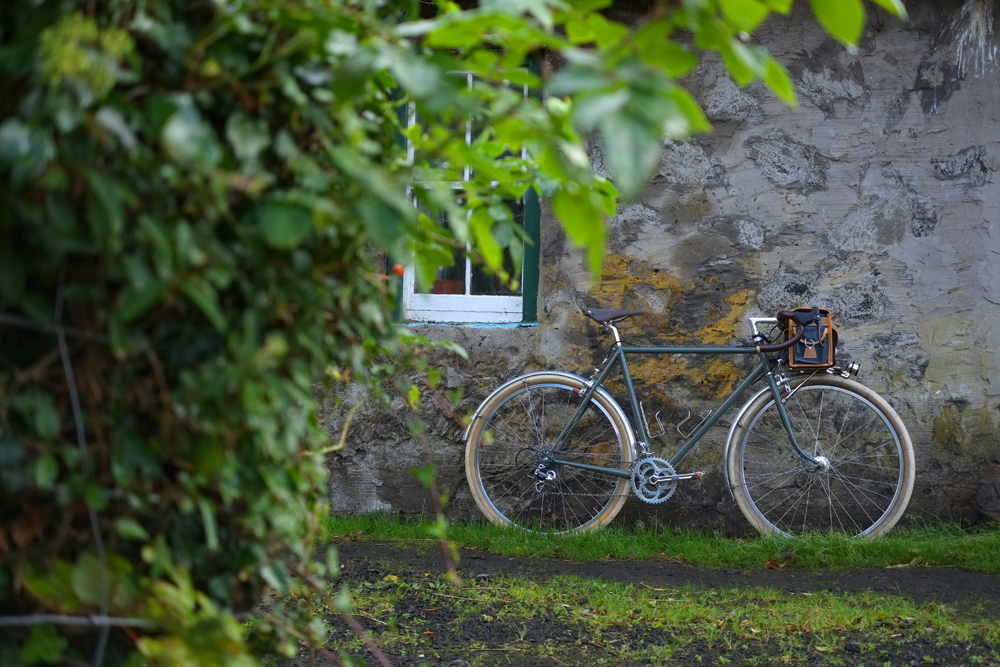
Among the people I know who have tried their hand at making a bicycle frame, I've observed a curious trend: After completing the project, most did not build up their bike straight away. In fact, some still have the bare frame hanging up on a wall years later, with only the vaguest of plans, if any, to turn it into a ridable bike. I did not understand it. I would have thought they'd be eager to ride the bike they made with their own hands. But that was before I went through the process myself - before I too felt the postpartum/PTSD-like aftermath of the framebuilding experience. For someone who is neither mechanically inclined nor endowed with physical strength, building a bicycle frame from scratch can be difficult, exhausting and, in truth, demoralising. In our culture of can-do, we perpetuate a myth that creativity and effort in of themselves will necessarily fill us with pride - that even if we do a lackluster job and our teacher holds our hand the whole way through, that portion of our psyche that is the internalised supportive parent will accept our blotchy finger paintings, saggy papier-mâché vases, and crooked macaroni picture frames with utter delight. Everyone gets a star! In reality, the act of making can fill us with shame and an acute awareness of our limitations. We come up against our own boundaries, and, instead of turning away as we'd normally do, we are then forced to spend time chafing against them only to reaffirm their steadfastness. It's uncomfortable territory to hang out in; an experience we'd soon rather forget. Except that we now have a memento of it! This may go some way toward explaining why it was 20 months before the frame I made, with the help of master builder Mike Flanigan, became a ridable bicycle.
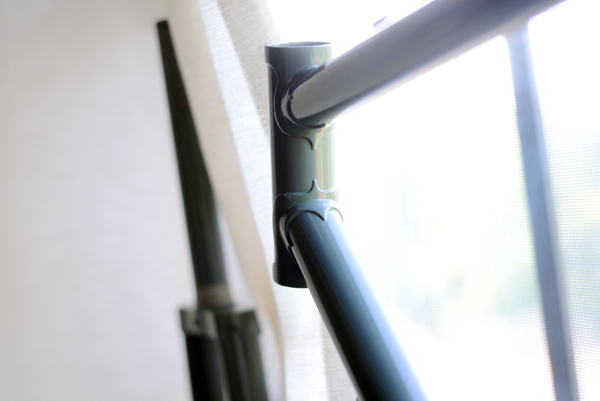 Nevertheless, one day I woke up and knew I wanted it to happen. I was visiting the US at the time and scheduled to return to Ireland in about a week. I was in the process of selling my Rawland, and needed to decide whether to sell the entire bike or just the frame, keeping the parts for what they were originally meant for - that is, my DIY bike. At the time I was building the frame, I had wanted it as a fast, go-anywhere bicycle that would be a notch better than the Rawland. However, by now, I no longer really needed such a machine - nor had the confidence that the thing I'd cooked up myself could actually be better than a tried and tested bike made by somebody else. But my reasoning was, that I could use a long-distance commuter bicycle in Ireland, with fat tires, drop bars, low gears, powerful dynamo lighting and a roomy handlebar bag - so I may as well ride my own. How it performed beyond these requirements almost didn't matter for my purpose, as long as it did not fall apart underneath me - so the risk of disappointment was low. I had no tools or stand with me to disassemble the Rawland or assemble the new bike, but it seemed a fairly straightforward job, so I asked old buddy and fabled bicycle assembler Somervillain to take it on, as part of a mutually agreeable barter exchange. Of course in the end it turned out to be not such a straightforward job after all - due to a couple of, ahem, mistakes I made in fork and rear brake bridge spacing. The words "okay, just throw the whole thing out then!" may have been uttered, melodramatically. Mike Flanigan may have gotten involved, insisting that the problem - which both Somervillain and I had diagnosed as catastrophic - was in fact fixable, then actually coming over and fixing it 2 days before my flight back. I test rode the bike for a total of 40 minutes - too stunned to form any impressions other than "it rolls!" - before it was wrangled inside my travel case and en route to the airport.
Nevertheless, one day I woke up and knew I wanted it to happen. I was visiting the US at the time and scheduled to return to Ireland in about a week. I was in the process of selling my Rawland, and needed to decide whether to sell the entire bike or just the frame, keeping the parts for what they were originally meant for - that is, my DIY bike. At the time I was building the frame, I had wanted it as a fast, go-anywhere bicycle that would be a notch better than the Rawland. However, by now, I no longer really needed such a machine - nor had the confidence that the thing I'd cooked up myself could actually be better than a tried and tested bike made by somebody else. But my reasoning was, that I could use a long-distance commuter bicycle in Ireland, with fat tires, drop bars, low gears, powerful dynamo lighting and a roomy handlebar bag - so I may as well ride my own. How it performed beyond these requirements almost didn't matter for my purpose, as long as it did not fall apart underneath me - so the risk of disappointment was low. I had no tools or stand with me to disassemble the Rawland or assemble the new bike, but it seemed a fairly straightforward job, so I asked old buddy and fabled bicycle assembler Somervillain to take it on, as part of a mutually agreeable barter exchange. Of course in the end it turned out to be not such a straightforward job after all - due to a couple of, ahem, mistakes I made in fork and rear brake bridge spacing. The words "okay, just throw the whole thing out then!" may have been uttered, melodramatically. Mike Flanigan may have gotten involved, insisting that the problem - which both Somervillain and I had diagnosed as catastrophic - was in fact fixable, then actually coming over and fixing it 2 days before my flight back. I test rode the bike for a total of 40 minutes - too stunned to form any impressions other than "it rolls!" - before it was wrangled inside my travel case and en route to the airport.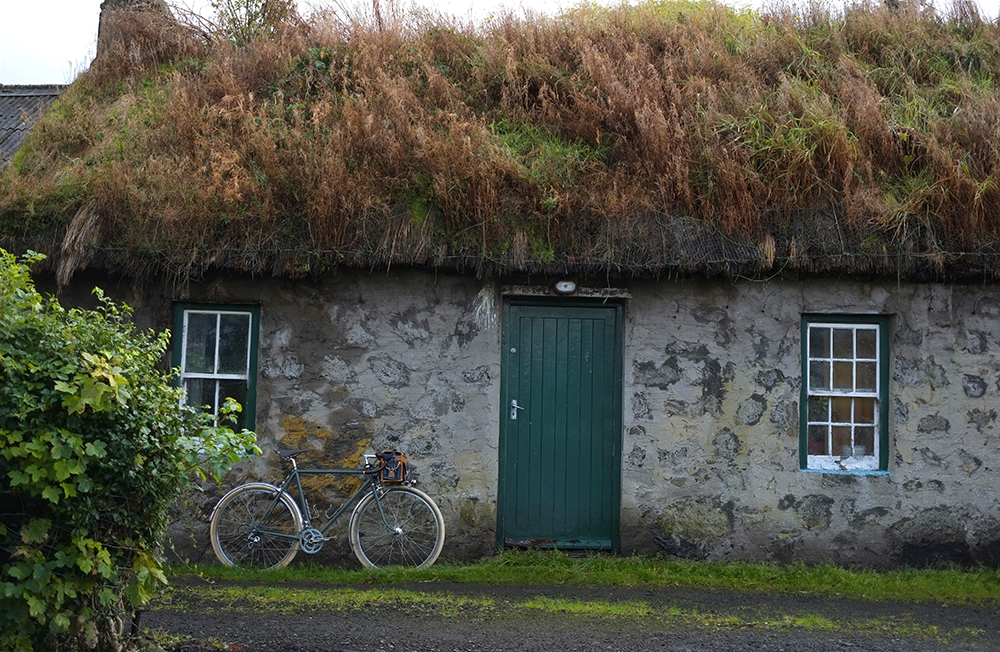
The following morning, the bicycle was out of the bag and on the roads of Northern Ireland. It took me some time to get over how convincingly bike-like it felt in action! Perhaps part of me was expecting for it to feel creaky or have obvious handling problems, or just, I don't know, somehow feel different from a normal bicycle - so, initially, the mere fact that it didn't dominated my impressions. It took a good few rides before I finally got over this and grew capable of processing the bike as I would any other machine - forming opinions about its ride quality, speed, handling, and other characteristics. And the shocking thing was ...I liked it. I couldn't believe it, but I really, really liked it!
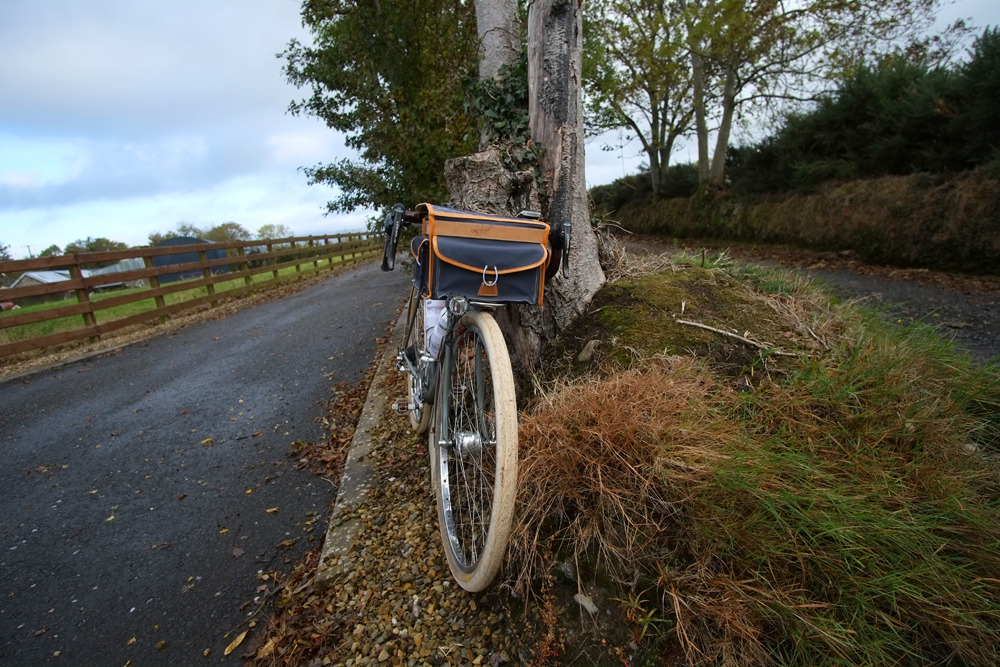
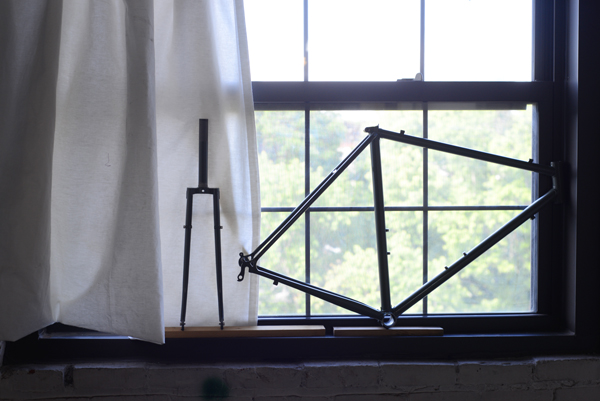
I designed this bicycle with True Temper super-thinwall tubing (7/4/7 with 8/5/8 downtube ), as well as super lightweight Kasei fork blades. The decision to stiffen the downtube was made, because previously, I had found the feel of several all-7/4/7 bikes I'd tried too flexible - whereas, for instance, the Rawland Nordavinden, with its 8/5/8 downtube, felt like it had just the right amount of flex for me. In fact, this bicycle's tubing specs and geometry are very similar to the Rawland's. The main differences in the latter are that my DIY bike is slightly smaller (shorter top tube and head tube) to better suit my proportions and preferred riding position, has a steeper seat tube, a slightly lower bottom bracket, and shorter chain stays. The decisions to make these changes from the Rawland's geometry, were, more than anything, based on a subjective intuition that I would "like it better that way." However, by the time I got done building the frame, and certainly by the time it was assembled, I had lost confidence that this would be the case. At the point I started riding the bike, I was just hoping it would ride close to as well as the Rawland.
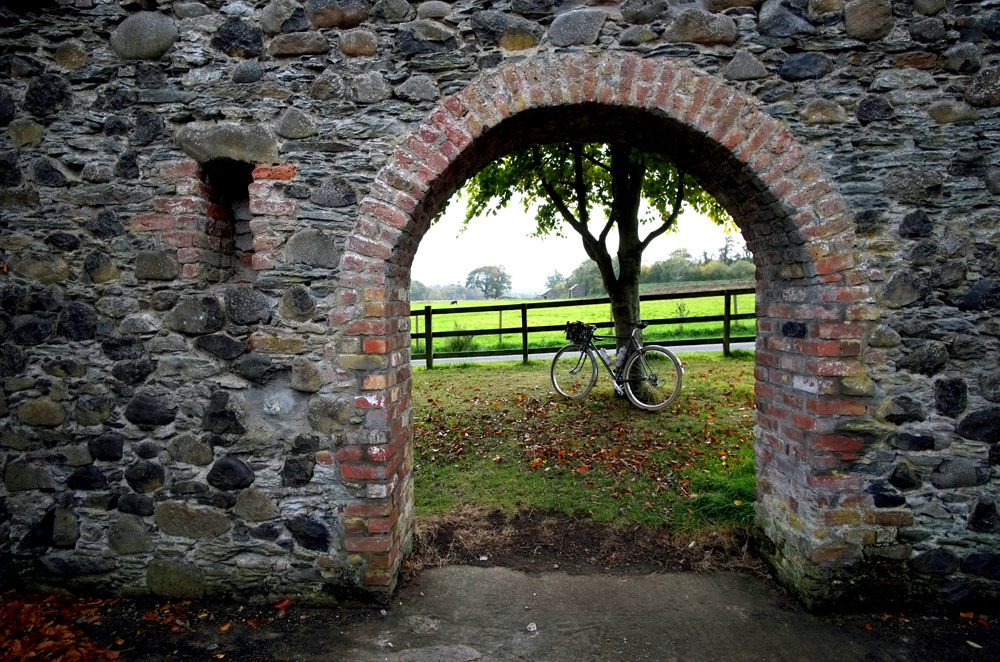
That said, compared to my skinny tire Seven titanium roadbike, there are differences in performance - albeit not as dramatic as I expected. On flats and mild-to-moderate inclines, the speeds of the two bikes are actually comparable at my typical riding pace, and it's only if I try to go all out that the Seven's performance advantage becomes apparent. The more noticeable difference is felt during steep, sustained climbs. At some point there comes a threshold beyond which the 650B bike begins to feel "heavy" - and I put that in quotation marks, because I am not sure this sensation literally has to do with the weight of the bike, as opposed to something else - and very much as if I am dragging it up the mountain with me. The Seven, on the other hand, continues to feel weightless even on the toughest climbs. I was not sure to what extent this was all in my imagination, until I took the DIY bike on this horror of a local climb I'd gotten accustomed to doing. This climb starts out difficult enough, and then just gets worse from there, for a continuous 6 miles, reaching a near-vertical pitch in the final km to the top. On my Seven, the last part this ordeal is difficult, but doable in my lowest gear (34/36t). On the 650B DIY bike, I had to get off and walk before I even reached the worst bit - the 28/29t gear just wasn't enough. Once I understood that I simply can't ride this bike up that particular mountain in the same way as the Seven, I adapted a different approach - pushing harder and standing during the last bit, to avoid stalling out. But my point is, that I don't have to do that on the Seven, whereas I do on this bike.

The payoff, however, comes during descents - which is my favorite part of this bicycle's handling. To put it simply, I do not feel the speed on this bike when going downhill. A plummet at 39mph feels not much differently to a 15mph coast down a gentle slope. If on the Seven, descents are 50% fun and 50% fear, on this bike the percentage is more like 90/10. This makes me a lot more confident on descents, enabling me to corner without braking, and thus go a bit faster.
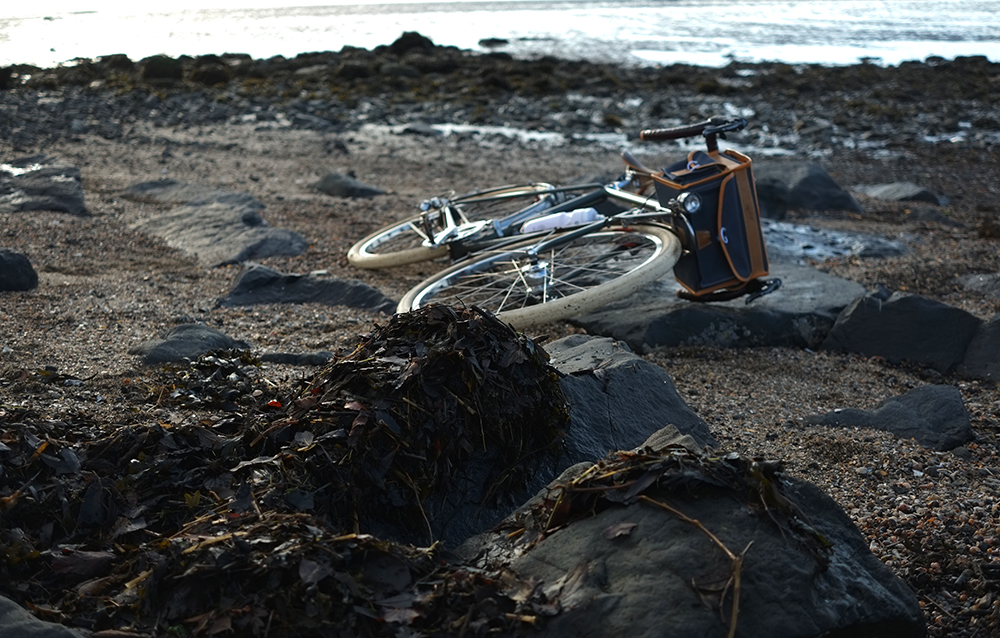
Another plus, is that the DIY bike seems to be more resistant to strong wind gusts - a common feature of winter weather around these parts.
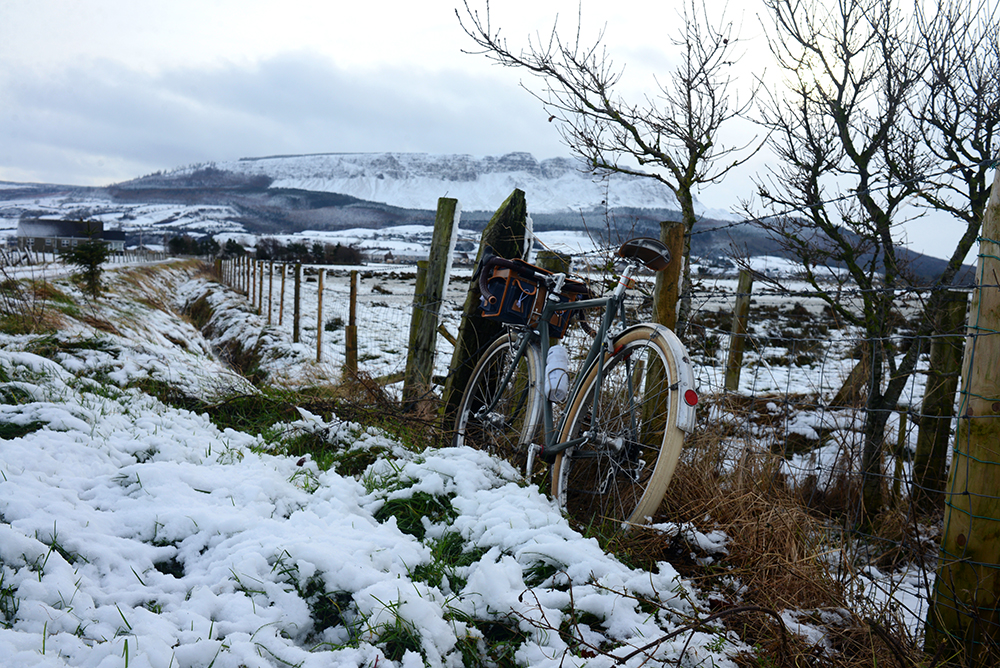
That, plus its obvious benefits in sleety and snowy weather due to the fat tires, makes the 650B bike the preferred choice for winter cycling a good part of the time. Overall, the extent to which I'm faster on my skinny tire roadbike vs this bicycle depends on the nature of the ride and the topography of the route. I am happy to have them both and I feel that, rather than competing, the two bicycles complement one another.
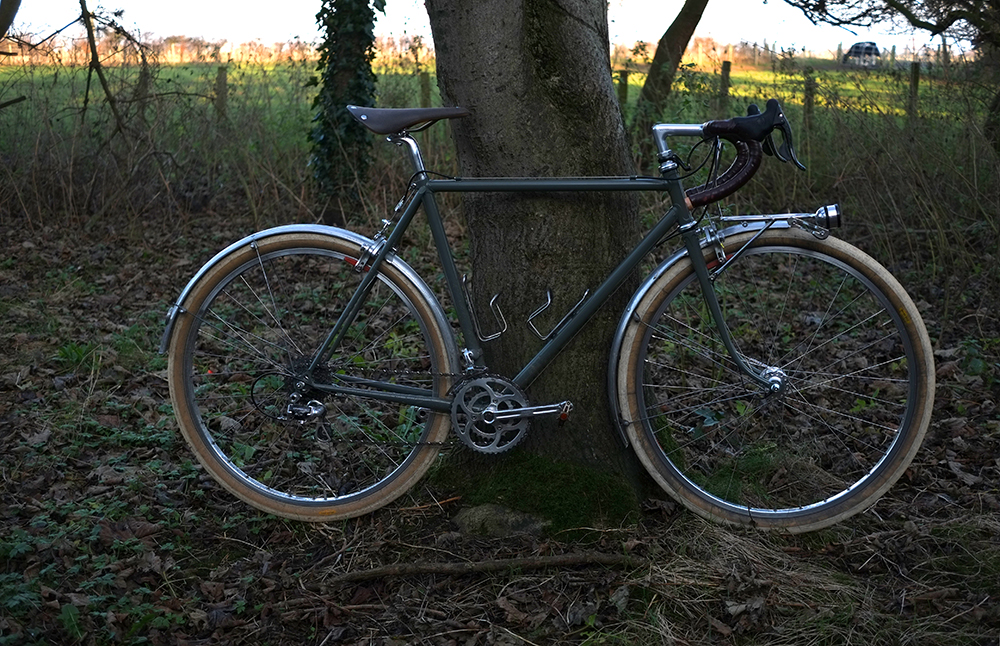
But enough comparing. I've had a lot of questions about this bicycle's build, so here it is: Most of the components have been moved over from the Rawland as described here. Namely, these are the wheels (Pacenti PL23 rims; Schmidt SON dynohub; White Industries rear hub with Campagnolo road cassette), tires (650Bx42mm Grand Bois Hetres), brakes (Paul's Racer center pulls - which, to my relief, stop just as well on the steep descents here as they did for me in Boston), derailleurs and brake/shift levers (Campagnolo Chorus 10-speed), Schmidt Edelux headlight, and King Cage bottle cages. There are also parts that are new to this bicycle.

Rather than keep the Rawland's White Industries VBC road double crankset, I wanted to try the Rene Herse crankset that I had acquired in a trade earlier. The rings on this crankset are 44/28t, which, with my 12-29t rear cassette, gives me the sub-1:1 low gear for hilly terrain. Overall, the setup works well. I find myself staying in the big ring most of the time, only employing the small ring on serious hills. Also, this crankset is very pretty! On the downside, I do find myself maxing out my high gears when playing "town line" games with friends. And the shift from small ring to big is not as carefree as it is on my Seven's compact Chorus crankset. I am going to give it some time before declaring this with certainty, but my feeling at the moment is that I prefer the Srampagnolo method of achieving low gearing, despite it being less elegant aesthetically.
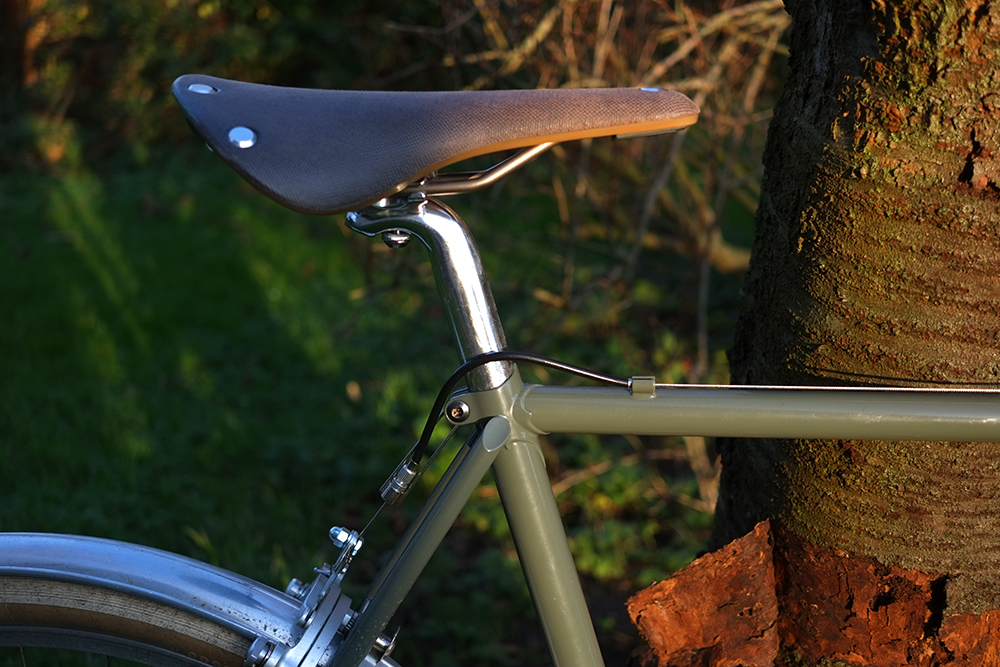
The saddle I have on this bike at the moment is a Brooks C-17 Cambium , which I shall post a long-term review of soon. I am not sure, however, if it's what will end up being on the bike in the long run.
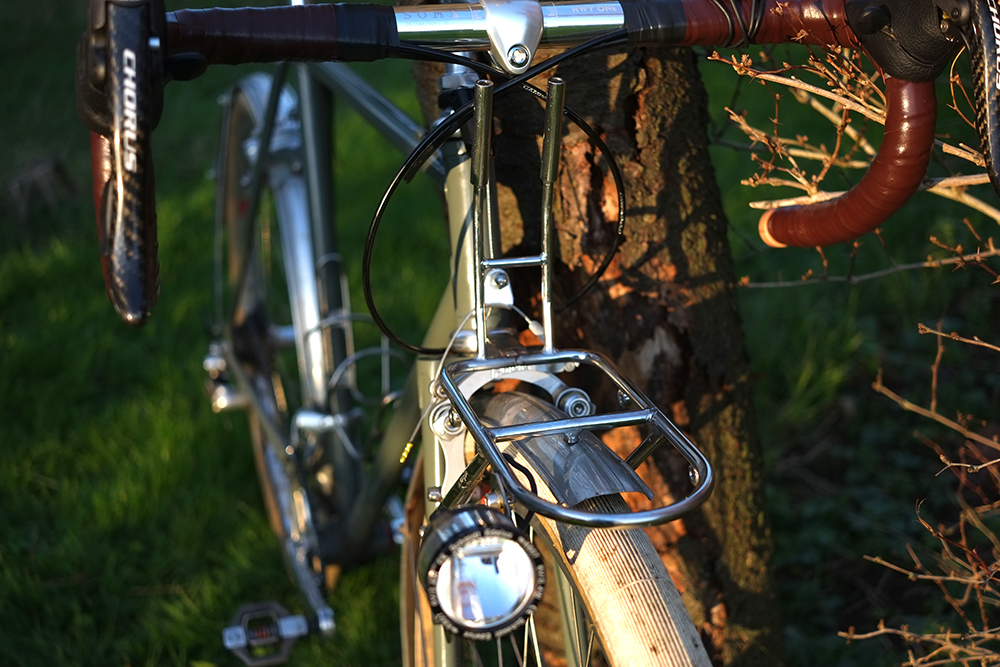
The front rack is a modified Velo Orange randonneur rack with integrated, detachable decalleur. When designing the frame I had planned to use this rack, and going by its description it should have worked. But when the frame was built, we mocked it up and discovered that the rack’s bracket would not clear the Paul Racer brakes in a way that would also allow the struts to reach the fork blades. So Mike Flanigan kindly sawed off the original bracket and welded on a new one, after shaping it to clear the brakes.
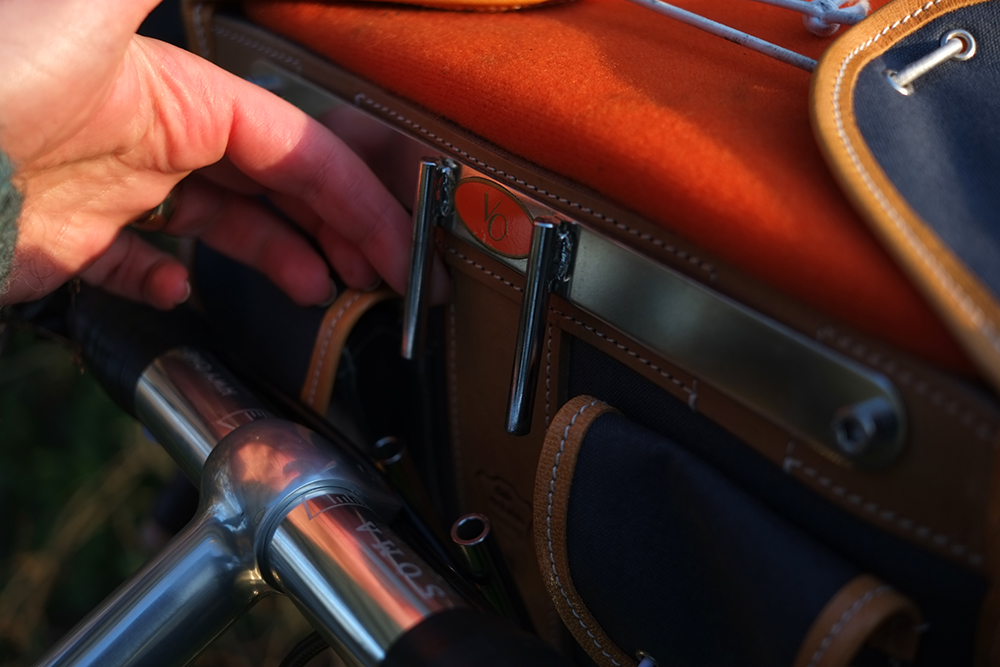
Thankfully, the rack is a perfect fit now and the detachable decalleur is quite a handy feature.
I should also mention that I had to alter the handlebar setup, as the Rawland had a threadless steerer, whereas this bike's steerer is threaded - so the stem could not be moved over. The only threaded stem I had lying around at the time was 110mm (I had a budget of $0 to spend on this bicycle's assembly, so it was either using existing parts or nothing). So I decided to use that with some Soma Hiway 1 short reach bars I also happened to have, achieving a similar overall reach to the Rawland's shorter stem/ long reach bars combo. Make sense? Of course it does!

Of course the part of this bike that gets everyone's attention immediately, whether they know bikes or not, is the sexy slate gray Berthoud handlebar bag with caramel leather trim. I had resisted Berthoud bags for some time, finding them just "too much" visually. But this Berthoud bag in small was actually the only production handlebag available that was petit enough to fit my bike, considering its short headtube. So even though this bag looks quite domineering in pictures, keep in mind that it's proportional to the bicycle. Even the small VO bag I had on the Rawland was too tall!
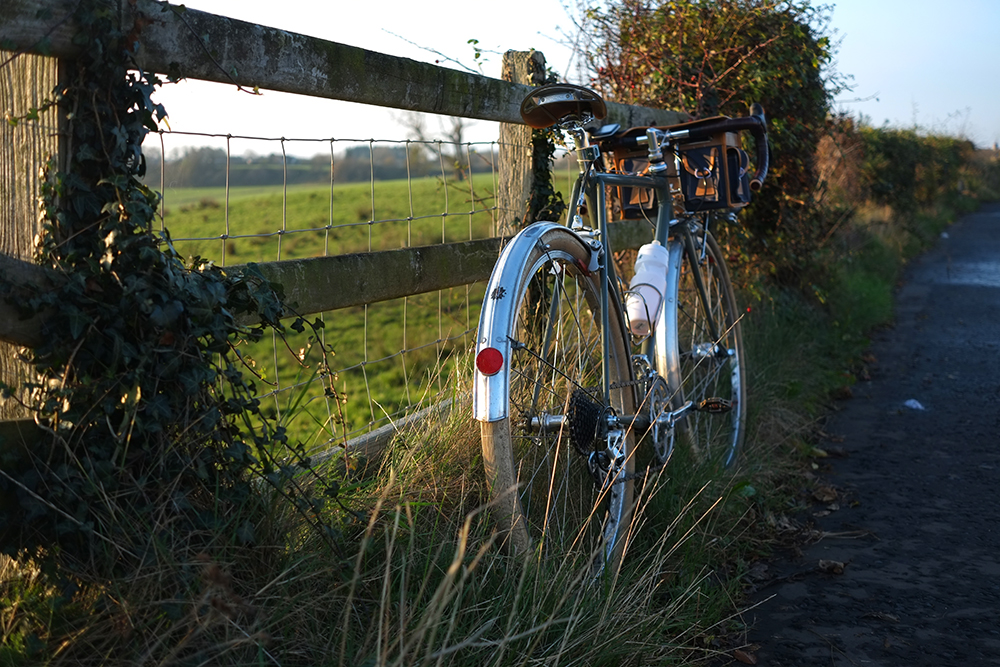
But for me, the piece de resistance on this bicycle are the fenders. Notice anything unusual about them? The Honjos I had on the Rawland did not fit properly (brake bridge spacing issue), so resourceful Nick of the Three Speed Hub suggested fenders with a more domed profile - namely, a pair of English alumnium ones he had lying about, circa the 1930s ...though to call them a "pair" is stretching the definition, since they are actually mismatched: the rear being a Britannialloy and the front a Bluemell Airweight. When Nick produced the ancient things, I thought he was joking at first. But they were actually very lightweight, and they worked splendidly. Unless you know, you really can't tell they are not a matched pair. And of course they look fantastic with the carbon fiber detailing of the modern Campagnolo rear derailleur!
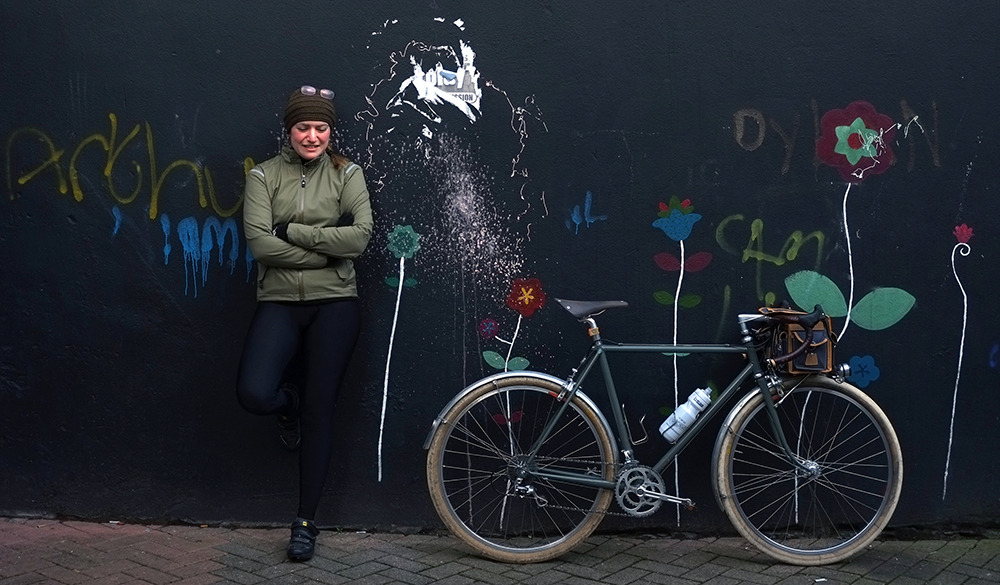
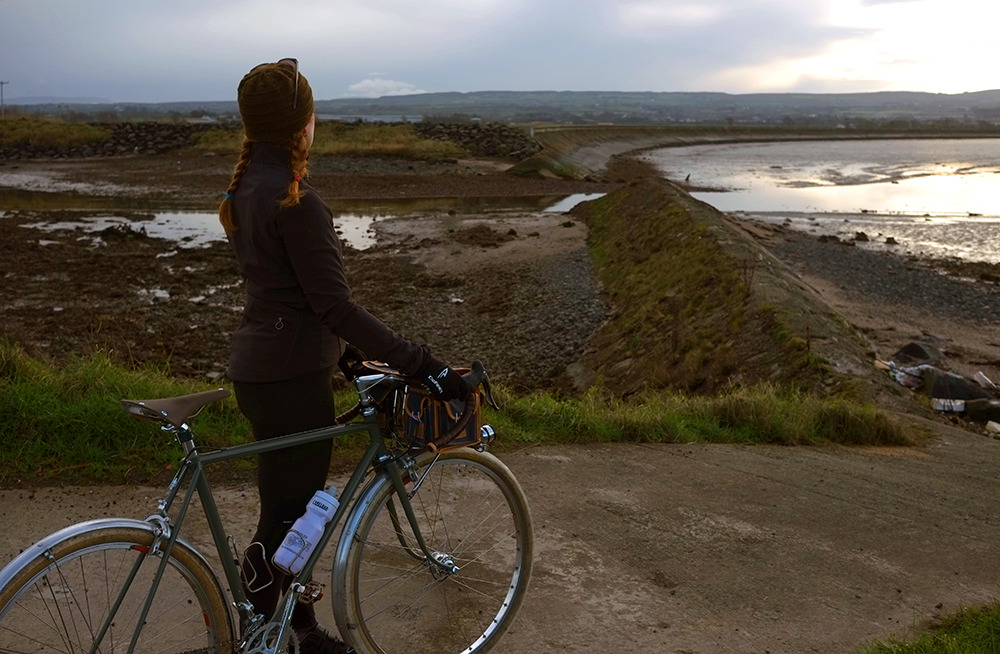

Very nice bike! Interestingly, you are using nearly identical gearing as I do on my Lemond, with the differences in rear cassette (12-30T vs. yours 12-29T) and the crankset - I can't praise my Sugino OX601D more: http://bostonbybike.blogspot.com/2013/09/low-gearing-on-road-bike-part-33-sugino.html . Once I tried it, I knew that 44/28T is just the best combination for do-it-all road bike. Unlike the Herse cranks, Sugino switches between chainrings very quickly and "carefree". Glad to read you also mentioned that smaller chainrings is the way to go when you need low gears. My opinion is that using a compact crankset and a 11-36T cassette is a dead end solution. Simply because if you need even lower gears you can't easily fit a larger cassette on a road hub or a smaller chainring in a compact crankset. Should you need lower gearing in your bike, just swap that cassette with a 12-32T and you're good to go.
ReplyDeleteInteresting you mentioned that while you can easily ride the particular hill on your Seven with 700c wheels and 34/36 gearing, you can't do it on this bike with 650b wheels and 28/29 gearing. Gearing on these two bikes is very similar, considering tire sizes, so I assume it must be something else that slows you down on your DIY bike.
I have used those Sugino cranks as well. At least when combined with Campagnolo, I did not find the setup 100% problem free. As I recall, the issue was chain drop when switching from big ring to small. The RH cranks perform better for me than the Suginos did. But the "Srampagnolo" setup performs better still. My impression is that the most functional system is one that keeps the drivetrain's native crankset.
DeleteAre you sure you've used the OX601D cranks? That's pretty new and is a funky super compact double with 2 different BCDs requiring the big ring to mount on the back of the spider tabs instead of on the front as you would normally mount a big ring. I don't remember ever seeing one on your blog(of course I don't always remember how to get home from the post office either).
DeleteI would have put a set of them on my new Seven but it's a 2 piece crank and I'm still firmly square taper so I made a bolt on spider for some Stronglight 49ds out of an old 110 BCD BMX spider and drilled another set of holes at 74mm BCD for the small ring. Works great and I get to use any of the 110 or 74 BCD chainrings that litter the ground where I live.
I don't know why anyone buys a cassette with an 11 for anything but racing and posing. I wish I could buy a 9spd 13-32 for around here, it was difficult finding a 12-32 for my new bike.
Spindizzy
I *was* sure, but will double check now. No, it wasn't on the blog. How new? the one I'm thinking of came out a couple of years ago.
DeleteLike last year I think? I don't see them in my 2013 Merry Sales catalog but they are in the 2014...
DeleteI was SOOO wrong. That crank has been out since 2012 and my Merry Sales catalogs were not from the years I thought. Neat crank non-the-less. When they make a square taper version I will buy 2.
DeleteI am running an OX601D crankset on my winter/gravel bike. I initially had chain drop issues, but they went away after readjusting both front derailleur stops. Sugino cranks have a narrower Q factor than most others, and the front derailleur simply needed to be readjusted to match. I am actually quite pleased with the front shifting, especially in comparison with the Apex compact crankset I was running before. That Apex front derailleur is nothing for SRAM to be proud of, but I now have only a 14 tooth difference between rings instead of 16 teeth and that has made a huge improvement. I am running 44/30 on the front, and a 12/32 rear cluster, which gives me a good climbing range while letting me stay in the big ring most of the time. I hated the 50/34 combo I had before because I was constantly cross-chained and bouncing from big ring to small ring and back.
DeleteI installed the OX601D on my Volagi with Ultegra. I am running an 11 speed chain, 11 speed cassette, Ultegra 11 speed STI levers, FD, and RD.. Went together beautifully.
DeleteI have a braze-on derailleur mount and had to move the FD very low. Used the WickWerks Fit Link to do it https://wickwerks.com/products/fit-link-adapter/. This made for a very clean install. I set it up with a 40/26. Everything shifts perfectly–better than the Ultegra cranks which were 50/34. I can use 21 of 22 gears with no rubbing: all rear cogs from the larger chainring and all but small/small with the inner chainring. Of course, really only the largest 5 cogs make sense with the inner chain ring.
It looks great and works perfectly.
I like your mix of high end and moderately priced components. With regards to the VO rack, does the decalleur stay in place securely when you go over bumps? Do you recommend it?
ReplyDeleteI really like the detachable decalleur design that VO uses on this Constructeur front rack, as well as their Pass Hunter rack. The decalleur does stay in place over bumps; it has not been an issue for me. The only thing to be aware of with these racks (and all racks where the stays are not adjustable) is fit. As far as I know, these particular front racks are not compatible with many production bike frames, other than VO's own.
DeleteAs a side note, the rack you have is called “Randonneur Front Rack with Integrated Decaleur”; the VO Constructeur rack is not available with an integrated decaleur.
Deleteabout fitting VO integrated decaleur rack, a point to notice is it limits the stem angle / lenght, depending on your frame size, if you want the decaleur not to get in conflict with the handlebar. It's so obvious that i didn't care about it witht my surly CC 54cm, and i had to change twice stem....grrr
DeleteThanks Christoph, you are correct. Too many product names and I've been out of the keeping-up-with-stuff game for a bit!
DeleteHello,
ReplyDeleteI remember the photo at the top of your old style blog (wordpress?), you had a photo of a 650B green bicycle. Was that not this one ?
That was not a 650B bike, but a Bella Ciao Corva Citta Donna. The colour of the powder coat was similar, and I had fitted it with 700Cx35mm Schwalbe Delta Cruiser tires.
DeleteSean Kelly preferred to sprint on 52x15. Cinelli book points "the already mature amateur sprinter or the professional" to 48x14 or 49x14. if you are maxing out on 44x12 the problem is not that the gear is too small, the problem is you've hardly begun to know sprinting. To even begin to learn to sprint you would be best served by adopting a much smaller ratio for the sprint and leaving that huge gear for downhill and downwind. Before Jacques Anquetil's later years bikes simply did not have gears as big as what you have there and it's very hard to imagine that you are as strong as Anquetil.
ReplyDeleteYou're right; I've hardly begun to know sprinting. Also, I was joking.
DeleteThe "feel" of the bike you describe was brought home to me recently as I acquired a 1974 Raleigh Sport three speed as my winter bike. I have been riding a Bridgestone 400 and didn't realize how comfortable the Raleigh would be with the steel rims and larger lower pressure tires especially in dealing with rough roads. The penalty for me is a slower overall speed, but generally I ride at the opposite end of the performance spectrum from most of your readers. Excellent article!
ReplyDeleteBut you never joke, V.
ReplyDeleteAs for the randonneur bike, Now we know The Rest Of The Story.
Heh. Glad that this thing turned out to be such a jewel. (I will admit that I had high expectations, anyway.)
Your writing on the post-brazum depression was kind of heartbreaking, in a sense. Some people feel it even when they've discovered that they really ought to be making the stuff that made 'em kind of crazy. Talk about a dilemma.
This morning I read this poignant blog post by Paul Sadoff where he relates coming to terms with his first frame.
After 34 years. It made me laugh a bit and think of your framebuilding.
http://overopinionatedframebuilder.blogspot.com/2014/02/you-want-it-when.html">You Want It When
Heh. He made his first frame a year before I was born. Great story.
DeleteYou and Paul Sadoff have a similar taste in seat clusters... :)
Deletehttp://overopinionatedframebuilder.blogspot.co.uk/2009/05/legacy.html
I knew I saw some UK pedigree in those fenders!! I have a set of Bluemels 700c Airweights I will polish to a dangerous shine one day and put them on my red Peugeot (which currently has matching red metallic Bluemels All Rounders) or a chrome P-15 Paramount I am putting together (at a dead snail's pace).
ReplyDeleteGreat to read all about it.
vsk
You're comparing this bike with giant tires to your 7 in feel? And it's "perceptibly" faster? Do you mean your Rawland is there with the same wheels/tires run over the same road back-to-back? Might one have been "measured" as faster?
ReplyDeleteAnd when were you able to distinguish between the feel of frame give and tire give - never been articulated here.
Of course you felt confident - there's little vibration coming through.
Velouria, it's a beauty!
ReplyDelete~ David Miller
Nice ride!
ReplyDeleteI've been following and admiring the build of this bike and it's nice to get the details. You've built it more or less the way I would like to do my own.
ReplyDeleteI love the 80 year old fenders, they seem to add a bit of whimsy.
Looking forward to the review on the Brooks C-17. I was just looking at one in the bike shop. Seems nice but way over budget for me.
This post exemplifies one of your most commendable qualities- both as a student of bicycles and a blogger - the capacity and courage to take on something new and daunting despite trepidations and be willing to flail and fail even and do so rather publicly. Here, especially, with the technical difficulties as well as the physical challenges you forged ahead and as it turned out, after all, did very well. And just as commendable had you failed miserably. Making things in the real world; yeah, there is no substitute for performance. Congratulations! BTW, the pictures for this post and your new blog layout are worthy of your writing. Very nice. Thanks for sharing. Jim Duncan
ReplyDeleteOff topic.
ReplyDeleteI noticed that Peppy hasn't commented in a while.
She has grown disillusioned in blogs.
DeleteIs the title of this post (and its fairly clear relation to the subject matter of the previous one) for V's amusement or for that of your Dear Readers?
ReplyDeleteSadly, I can claim neither. This post and title already existed in draft form before yesterday's post happened. But it's a fun coincidence.
Deleteok, the frame is cool, but the fenders are stunning! without laughing, a very nice project, and great realisation (love the lugs).
ReplyDeleteBy the way, i look forward to hear about the saddle, find it a bit pricey for what it is but meaby the "performance" are valuable
Great story and great bicycle. another enviable ride. i think we have very similar tastes. your build is almost exactly what i would do on my "dream" ride, including building my own frame. i never thought about using those blumels airweights. what a great choice. once I get enough money to get a new bike, i'll probably ask a frame building friend if he would be interested in helping me build one.
ReplyDeleteThe fact that it took you so long to build this bike is interesting to me...
ReplyDeleteMy experience has been that the longer I work on a project and the more compromise(real or imagined) is involved the more ambivalent I am about it by the end. It's not that I don't want it anymore or have lost interest, it's just that somehow expectations get so beat down that the whole endeavor seems unlikely to succeed. By the time it's nearing completion I've convinced myself that really I should just move directly to Beta and do it "Right". Usually the expense of starting over forces me to wait for more wads of unencumbered time and money and at some point I decide to just go ahead and drop the engine back in or put a crank and some wheels on it and see how bad it is. The more ambitious the plan, the harder it is hard for me to maintain any degree of excitement after the first 25% of a project is complete and it doesn't come back sometimes until I'm hooking up the battery and priming the fuel pump or closing the quick release before the first ride. I've not had any real failures yet and like your bike, sometimes they're inexplicably awesome.
I wonder how common that is? HEY COREY! Are you still building guitars? Any of this sound familiar?
Spindizzy
Oh yeah, the reason I clicked "comment" was to say that I think the color of that bike is absolutely perfect. I can't imagine another color looking so harmonious and appropriate in the settings you've been photographing it. I like the fact that it's really a very traditional color on a bike that manages to so sweetly incorporate much new thinking with useful traditional practice. The fact that the fenders are as old as my Dad makes me happy too.
I like that the colour is neither too brown nor too minty, as some of my past attempts at mil-spec green have been. This shade is just right. And it goes with everything - fabulous!
DeleteI have five-count 'em-five guitars in various stages of halted construction as we speak. It's a little too familiar.
ReplyDelete(Hence my comment above about realizing that you're supposed to be doing this thing that makes you nuts.)
And yeah, those fenders...V, they really tie the room together.
Makes me wonder what size they were made for originally, seeing how well they fit 650B tires.
I bet those fenders were for a 26 x 1 3/8, lot's of old fast Brit bikes used that size. I've been leering at an late 40s Maclean frameset a friend has in my size that was built for that wheel size. It was originally a time trial/general purpose/touring bike in the classic English style from back then.
DeleteSpindizzy
You're thinking of 26x1-1/4. ERTRO 597mm. Also used on Schwinns as 26x1-3/8. Most 700c wheels/tires work just fine with fenders meant for 26" 3spd. Now we know it works for 584 too.
DeleteCorrect rims and tires are scarce for something like that MacLean. And real NOS Dunlops are only to display, not to ride. Sprints (tubulars) were always an option, even in 1948. Easiest and best way to restore. If you want an extreme old-timey look it would be as easy to find a still functional pair of cane wheels as to find good Constrictors.
DeleteDoes the DYI bike have a name? Or have you gotten away from naming your bikes?
ReplyDeleteIt's Alice.
DeleteIt suits her - she's your conveyance in wonderland.
DeleteUh, I meant DIY bike. Not to be confused with a "DUI bike," a type of machine that's advertised quite frequently in my local Craigslist. Typically it's a Roadmaster or Huffy fitted with a noisy, smoke-belching 2-cycle engine. The target market for such a beast is the guy who has lost driving privileges but still needs to get to work.
DeleteI've a couple artist friends who decided to build themselves a bicycle frame. They craved an escape from the rigors of their 2D expressions and felt this would be a good way to keep their hands busy and engage themselves in a different passion. So off they went to hang out with a local builder. About a year and a half later two frames were ready for all the parts to be added and they were chomping at the bit to finish them off and put them to use. It was a long time coming. I think with their art it was never exactly/comfortably complete -- sort of a constant continuum -- and this was a change and opportunity to stick with something which could actually be tested. It helped them more than the anticipated.
ReplyDeleteYour bike looks worth the wait.
Mr. Shimano and the Taiwanese bicycle industry makes a strange hissing noise. I, on the other hand, make a happy french gesture.
ReplyDeleteHmm, where is the bell?
ReplyDeleteMaybe it’s not useful in your coastal area. To me it’s necessary if you live in a crowded downtown, it’s my case.
It’s a beautiful bike, it seems to be more or less a copy of Royal H 650B, isn’t it?
L.
Apart from both being low trail 650B bikes, not really. The lugs, tubing, geometry, size, and components are different. But both do sport gray Berthoud bags.
DeleteI've been harbouring a nice little copper bell just waiting for this bike to be built up, but haven't yet attached it. As you say, it's not really useful here. Though to be honest, although I like the idea of them, I have not found bike bells to be useful in the city either. They never seem to have the effect I want them to have. Motorists do not hear them. Pedestrians hear them, but get confused and do the opposite of what one might hope they'd do upon hearing the ring. Other cyclists hear them and get annoyed. Maybe I'm doing it wrong.
I agree re bells - I removed mine from my bike - apart from the fact that they are quite useless I think they look horrid on a mountain bike. Perhaps on a classic, comfort or hybrid bike they provide a complimentary decorative touch but otherwise they are just unnecessary clutter. By the way, your bike is beautiful - lovely photos - well done.
DeleteMy 120 dB fog horn always clears my path. It also stimulates bowel movement.
DeleteDon't descend in fear. Not 50% or at all. Fear is a huge distraction from the task at hand. It is never about gritting your teeth, steeling your nerves and plunging into the abyss. All that only leads to mistakes and mistakes lead to falls. You do not want to fall at 39mph. If that means you ride and wait another year before 40mph descents so be it. Lying on the pavement slows you down a lot.
ReplyDeletePresume you know the basics of getting your butt back, getting weight low, looking at where you want the wheel to go and not looking at objects of fear. There's one simple thing you can do at the level of equipment. Use a bigger tire on the front. When descending most of the weight is on the front. When braking or cornering downhill basically all the weight is on the front. You can demonstrate this by squeezing the rear brake on a steep pitch. As you start braking it is noticeable the brake slows the bike less than normal. Continued deceleration transfers weight to the front wheel and then the rear brake does nothing at all. So put some tread on the road where the weight is. Crit riders sometimes do this and can corner harder until the rear wheel drifts loose. Once the rear wheel drifts you can't push one bit harder. But the bike follows the front wheel through the turn and it's all much more stable and predictable than it sounds. And much more normal than it sounds because the front wheel was always doing most of the work anyway. I'm not recommending you try drifting your wheels on descents. Not yet. The feeling of security will be there with big rubber on the front.
I'm not sure if you've already discussed this topic in your blog but I'm wondering what you think about the costs associated with all these bikes -- of building one's own, of owning so many over the years while tinkering with feel and fit, of maintaining them -- maybe some thought in hindsight with regard to the expenses. You've written about the benefits and joys of cycling and learning about different bikes but as I think about expanding my understanding and experience the price seems stunningly high. A conservative estimate of what it'd cost to acquire bikes of equal quality to yours quickly puts me over twenty grand even if spread out over five years. Do you have advice, regrets, insight with regard to costs, whether monetary or otherwise? My point is I'd like everyone to find their sweet spot with regard to making cycling part of their life/lifestyle and expectations but it's often confusing and overwhelming and many are shocked when they add up the dollars. You write essays with personal observations and experiences. What about costs? Thanks.
ReplyDeleteCost is a tricky topic, because there are different ways of looking at what is "cost effective.” It is heavily context dependent. And if you really want to be thorough about it, you have to look not just at the bike, but at the person's lifestyle as a whole, and especially at what the bicycle is facilitating/replacing for them. You have to ask questions like, what expenses are eliminated because of the bike(s)? That sort of thing. These are difficult calculations to make.
DeleteAs far as looking at my own experiences - naturally, they will not translate to the situation most of my readers are in. I write about bicycles professionally (in the sense that I derive an income out of the process) and do other freelance work (photography, consulting) within the bicycle industry. So a good portion of my bike purchasing, bartering, and tinkering is research-driven and falls into the category of business expenses.
All that said, I've had a few posts addressing cost in the past, though mostly relating to transportation bicycles. However, they are rather outdated at this point and it would be good address the topic again, so thanks for the reminder.
Few things to consider A. One is that I see a lot of people buying different bikes that are basically the same bike over and over. Granted they may be very useful separate categories like MTB, Touring, Racing, Recumbent. At one point I had those, and not one of them was better than LX, mostly in the 1-1.5K range, except the much more expensive recumbent. I sold all but the MTB, and decided that touring was it for me (versatile anyway), and I would never buy anything but the very best from that point on. That actually won't cost all that much, when compared to all the mid priced bikes. I even see people buying 4 all but identical bikes, because the magazines make them want to test stuff, and they spend 6K that would have got them a Sachs or a Mariposa. Of course there are good reasons for one cheap bike, or multiple mid priced bikes. All I am saying is I see lots of people with their noses pressed to the custom bike window who think it is economics that is stopping them when it is serial junk purchases.
DeleteWhen you buy the best, you can often keep it a lot longer, and it ends up cheaper. There are several reasons for that. Sometimes you hit the wall. A bike that fits perfectly in every way, and lacks nothing component wise, can take the need to buy stuff out of you. If you always had compromises before, a perfect bike may actually satisfy; As with suits and shoes, sometimes the cost per use is lower; vintage beauties all started out as bikes that were good enough to stick around. You have to start somewhere.
You will rarely save money making your own bike (using a hot process). I make my own stuff because I like it. If it costs more or less it doesn't mater. There are deals out there were you can get a frame build course complete with frame for about what a good custom frame costs. But that is a good custom frame; Usually the guys offering the courses aren't top builders. Where it really pays is if you want the build experience. For someone who wants that, and gets a frame to boot, those are great deals.
One of the things that deters people buying upper end equipment is whether it is actually better, and whether it is worth it. Not in all cases, but bikes are a case where it often is. You are getting quality; design; fit; and execution, and for the most part it is fairly cheap. For instance thanks to CNC, number for number Phil freewheel hubs are very close today to what they cost in the 70s. In the 70s a set of 5 speed hubs was about the same price as the Simplex level Peugeot touring bike I bought with my paper route money. Today that bike is 1-2K comparable quality. I don't have a high end use for which only a custom bike will get the job done (except some fit issues), but the value is certainly there.
This bike looks very at home in Ireland, from the color to the mix of old and new. Congrats
ReplyDeleteGreat article, beautiful bike.
ReplyDeleteWhen working on projects, I've experienced: Fear at the beginning - as there's so much to do; Drive to get it done it in the middle - just keep working, no longer taking pictures of the process and progress; Emptiness at the end - as now what am I going to do?; and sometimes: Burnout at the end - no desire to touch it or anything like it for at least six months!
20 months! Pah! It was 15 YEARS after I bought a used frame and fork before I got to work completing the build on it. It's a track bike too so there's almost nothing to it. I really look apathetic in comparison. Actually I still haven't bought and installed the Keirin clamp-on front brake so I can't even say it's really complete...
ReplyDeleteI did not see you mention geometry other than smaller, lower bb, shorter chainstays. Did I miss it, or can you comment?
ReplyDeletedescents are 50% fun and 50% fear, on this bike the percentage is more like 90/10
ReplyDeleteI might put myself at 30/70. What do you think makes the difference?
Really enjoy your blog.
Re: bike bells. Yes, motorists don't hear them and pedestrians are often confused by them. When it's too noisy for a bike bell to be heard or I need a more emphatic alert, what I've found recently to be effective on multi-use paths is a bicycle whistle. Soft, polite, toot toots (the little train that could) seem to be heard easily and are not too intrusive and a loud, energetic whistle for emergencies, including clueless dogs, coyotes about to T-bone. Also, handy in overtaking motorized maintenance vehicles like golf carts. 'Course this doesn't work if you're breathless:)! Maybe not a style thing but safety on some of the paths I bike trumps image. Thanks! Jim Duncan
ReplyDeleteI just carry a boom box in my basket. Folks always know I'm coming.
DeleteThere was a legendary TV darts commentator called Sid Waddell - a Geordie - who, when the Welsh player Leighton Rees, one of the early darts heroes, shot 180 (three treble twenties) back in the day when that was still a phenomenon and not routine, said (you have to 'hear' this in a Geordie accent), "Theh's oenly oene woed fo' tha': quin'-e-ssential!" It's the only time I've ever heard the word 'quintessential' used, in any accent. Well... Theh's oenly oene woed fo' tha' bicy'le: quin'-e-ssential! :)
ReplyDeleteThe challenges of building something by hand especially in precision metal work are why there are apprenticeships. Trying to come at it from the outside, starting at the top so to speak, is guaranteed to come with lots of frustrations. That should be better understood. People see someone experienced in a mechanical art doing it - say, building a bicycle frame - and they say "yes, I could do that". But they don't see the years of acquired experience that gives the subtlety of manual skills. Those experienced craftsmen did not come out of the womb with some magical "mechanical skills" that others can't have. They developed them the same way you develop any skill.
ReplyDeleteI agree with you. And despite having gone into the experience knowing this, the very experience of having it reaffirmed blew my mind.
DeleteNice read, especially the first three paragraphs. Thank you.
ReplyDeleteAlice is SO beautiful, Velouria. Vintage fenders! I love the way they tie together your now-well-known ability to mix modern and traditional/vintage in whatever form fits the desired end. Also love the green. I can't verify that it's the same shade Mike put on my ANT Light Roadster, but mine has that 'not too brown, not too minty' quality you describe. I've decided it's called Flanigan Green ;)
ReplyDeleteReally looking forward to your review of the Cambium. I bought one and it was so painful - despite the fact I really wanted it to be great. I have now replaced it with a Brooks Imperial which is super-comfortable straight out of the box. And it looks beautiful!
ReplyDeleteJohn
It all turned out beautifully. I recognize many of those parts. My only regret is that it is extremely unlikely that I'll ever get to test ride your frame and build.
ReplyDeleteVery wise commentary on the psychology of the DIY extremist. I almost want to make everything, and am remarkably capable, but it is reaching the point where the well equipped woodworking/metal (anvil jig to mention just one piece)/sewing shop is almost operating as a barrier to not have to start projects when I am 45 years into my better skills and well able to design and complete within them. Now I have such a huge to do list just to get started I may never complete anything. Fun at times though.
ReplyDeleteTom
Oh, on the not building out the bike, there are a number of things. One is economic in that while when approaching a custom frame project, unless one is a pro who knows all the components he normally builds around, it should be standard practice ATMO, to procure all the parts in advance. Having answered thousands of frame building questions, a good proportion on design can be answered from measuring up an existing bike, And a good deal of questions on the jigsaw puzzle of things like your bag; chain line, how the wheels or brakes will fit, can be answered by procuring, at least all the sketchy parts, before one starts.
ReplyDeleteBut both out of doubt, and a natural tendency towards economy, most people want to see the frame finished before they make the expenditure. In particular, this makes "custom" a little more difficult, as many touches may depend on the overall picture, and why build a "custom" bike if it starts as an amateur made Surly stock frame.
If nothing else then, when the frame is complete a lot of people don't even have the parts to finish, after having spent a tidy sum on the course, or whatever else it was that got them to where they are at that point.
Of course the psych factors also play a large part.
Tom
what is the motivation for making your own frame that in the end looks pretty much like any other? I can't see it myself. ok if you're going to do some radical or unusual design then fair enough. great images tho, ty
ReplyDeletegood stuff
ReplyDelete